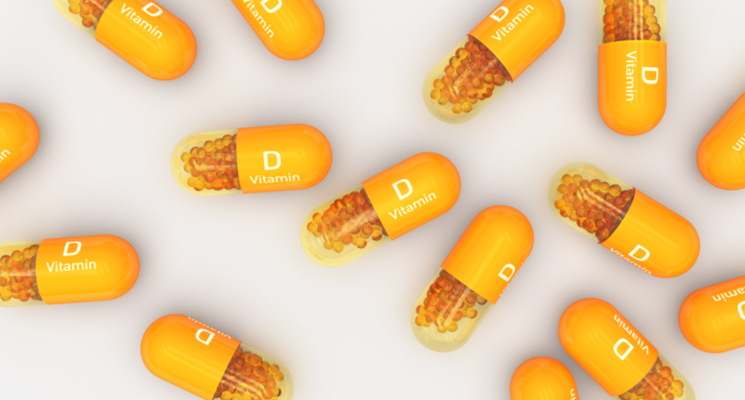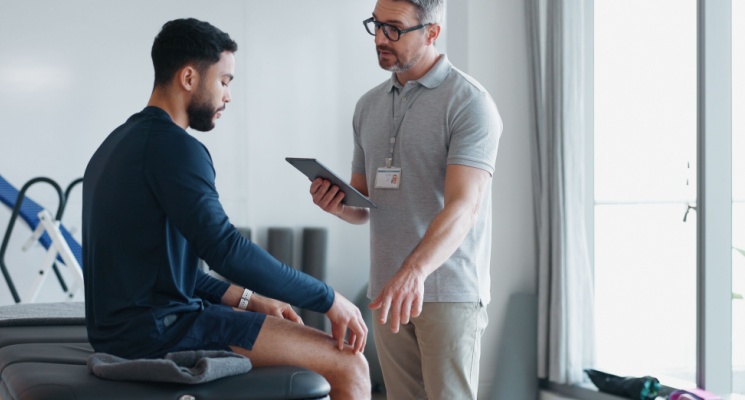In a world where everything turns at the click of your fingers, there is very little reason to venture out into the great big outdoors. This could potentially lead to health issues associated with lack of sun exposure. One of the most common issues resulting from this is deficiency of Vitamin D, an important nutrient that is derived through exposure to direct sunlight. People experiencing vitamin D deficiency may feel bone or muscle pain,[1] loss of appetite, fatigue, trouble sleeping, hair loss, and other symptoms.
Is Vitamin D Important?
Much like its name suggests, vitamin D deficiency occurs when your body doesn’t get sufficient amounts of it from sunlight or diet. Being a sun-born chemical, it helps in the absorption of calcium and phosphorus, and plays a very crucial role in bone development and building up your immunity. It helps improve your overall health by facilitating muscle and bone repair, regulating a good sleep schedule, and improving stamina, and overall agility.
Is Vitamin D Deficiency Common in the UAE?
Vitamin D deficiency plagues approximately one billion people worldwide.[2] As per a study conducted by the Dubai Health Authority, 29.5% of people in Dubai were found to be vitamin D deficient. 63.6% of them had levels that were below 30 ng/ml.[3] Here are two major reasons why this might be:
Weather and Climate
One of the biggest factors potentially contributing to vitamin D deficiency in Dubai could be its dry, arid, and hot climate. Due to the extreme weather, life in Dubai is usually limited to indoors. The city has been planned such that its infrastructure eliminates the need to step into the sunny (and hot!) outdoors. As a result, people may have very little sun exposure and may not get adequate levels of vitamin D.
Melanin Content
According to the Eastern Mediterranean Health Journal and the Journal of Nutrition and Metabolism[4], one of the things that can make people naturally prone to vitamin D deficiency is having darker skin. According to the Office of Dietary Supplements (ODS), dark skin has more melanin content, and higher melanin levels prevent one’s ability to synthesize vitamin D from the sun.[5] Therefore, people with darker skin have trouble absorbing enough vitamin D, which may cause them to develop its deficiency.
What Are the Main Causes of Vitamin D Deficiency?
There are several reasons[6] people may develop vitamin D deficiency. Here are a few of those:
- Insufficient sunlight exposure
- Lack of Vitamin D-rich diet
- Malabsorption problems that may prevent absorption despite a healthy intake
- Prescribed medicines that may tamper with the conversion and absorption of vitamin D as a side effect
- Kidney or liver problems that might prevent vitamin D from being converted to its active form in the body
What Happens if Low Vitamin D Goes Untreated?
The more direct impacts of vitamin D deficiency may be less detrimental but can potentially become gateways to more serious problems. They vary based on age.
Adults:
Vitamin D deficiency in adults causes loss of bone density, resulting in diseases like Osteoporosis, in which one may easily fracture or break bones. To compensate for the lack of calcium in the blood, the body borrows it from your bones, leaving them deficient and prone to breakage due to demineralization. It may also increase your chances of developing Osteomalacia or soft bone disease.
Lack of calcium and phosphorus absorption may also cause hypocalcemia or low calcium levels in one’s bloodstream. Consequently, the body may go into hyperparathyroidism, in which overactive parathyroid glands try to self-regulate calcium levels in the body. Both hypocalcemia and hyperparathyroidism[7] can potentially result in muscle cramps, weakness, fatigue, loss of appetite, dry eyes, and even depression. Other medical issues, such as high blood pressure, cancer, diabetes, autoimmune conditions, and arthritis. However, more research is needed to define a proper causal relationship.
Children:
Vitamin D deficiency in children can potentially cause Osteomalacia and Osteoporosis in children. This condition is called ‘Rickets – a rare disease in which bones soften up and bend due to demineralization. It may lead to permanent bone deformation. Amongst younger children or babies, it may manifest as pain, a delay in walking, or in severe cases, growth and development complications. They may develop joint problems[8] such as genu valgum or ‘knock knees’ wherein a child’s knees protrude inwards, and potentially ‘knock’ into one another as they walk, while their ankles stay apart. In other cases, it may even cause genu varum or bow legs, causing children’s legs to curl outwards around the knees and inwards around the ankles.
How Much Vitamin D Does the Body Need?
The amount of vitamin D needed by an individual varies based on age, which is the primary demographic factor that is used to determine dosage. Below is a list of recommended dietary allowances (RDA) established by the Food and Nutrition Board (FNB)[9] of the Washington DC Institute of Medicine, stating how much vitamin D each age group requires: *
- Babies (0–1 year): 400 IU
- Children (2–13 years): 600 IU
- Teenagers (14–18 years): 600 IU
- Adults (19–70 years): 600 IU
- Senior Citizens (70+): 800 IU
- Women of any age who are breastfeeding or pregnant: 600 IU
*Some patients who are severely deficient may need more. It is recommended to consult your doctor or healthcare provider.
Too much vitamin D intake is also dangerous. Vitamin D toxicity[10] can be hypercalcemia, which is too much calcium retention in one’s bloodstream. The build-up can cause nausea, dizziness, disorientation, vomiting, frequent urination, and weakness. It may also potentially lead to kidney damage or even heart disease in extreme cases.
The good news is that Vitamin D toxicity cannot be caused by natural sources of vitamin D because they do not carry excessive amounts of it. It can only occur through artificial means, such as through over-medication.
How Can I Raise My Vitamin D Levels Quickly?
Food Intake:
The best way to go about boosting your levels is to follow the natural order of things, i.e. having Vitamin D-rich foods. Vitamin D naturally occurs in many different foods and food groups, some of which include:
- Orange juice
- Beef liver
- Cheese
- Egg yolks
- Fish high in fat content e.g., Tuna, & Salmon
- Fish oil
Supplement Consumption:
Another way to boost vitamin D intake is by consuming it in its processed, concentrated form. This is higher in dosage and, therefore, can have far quicker results. You can either get them in the form of tablets or injections as per your doctor’s advice.
For some people, going to the doctor is not possible due to health issues that restrict their mobility. Sun exposure is something we definitely recommend, but not at the expense of your health! If going out for Vitamin D is not an option, it is best to still keep it in check if the situation requires. ServiceMarket enables you to consult a doctor at home by requesting a visit and booking the service through our app. A doctor can assess your general health, understand your symptoms and recommend if you need to have your Vitamin D levels tested. When required, you can easily book a Vitamin D test and other blood tests from the comfort of your home using the ServiceMarket app.
Wishing you a sunny day!
[1] 9 Vitamin D Deficiency Symptoms (and 10 high vitamin D foods) | University Health Center. (n.d.). https://health.unl.edu/9-vitamin-d-deficiency-symptoms-and-10-high-vitamin-d-foods
[2] Vitamin D Deficiency: Causes, Symptoms & Treatment. (n.d.). Cleveland Clinic. https://my.clevelandclinic.org/health/diseases/15050-vitamin-d-vitamin-d-deficiency
[3] Abdelgadir, E. I. E. (2016, April 17). Vitamin D Deficiency, the Volume of the Problem in the United Arab Emirates. A Cohort from the Middle East. https://symbiosisonlinepublishing.com/endocrinology-diabetes/endocrinology-diabetes44.php
[4] Sun-drenched Middle East has a high vitamin D deficiency rate. Why? (2019, June 10). Arab News. https://www.arabnews.com/node/1508576/food-health
[5] Salomon, S. H., & Laube, J., MD. (2021, January 29). Does Vitamin D Deficiency Pose a Special Risk for Black People? EverydayHealth.com https://www.everydayhealth.com/vitamin-d/does-vitamin-d-deficiency-pose-a-special-risk-for-black-people/
[6] Vitamin D Deficiency. (n.d.). https://medlineplus.gov/vitaminddeficiency.html
[7] Vitamin D Deficiency: Causes, Symptoms & Treatment. (n.d.). Cleveland Clinic. https://my.clevelandclinic.org/health/diseases/15050-vitamin-d-vitamin-d-deficiency
[8] Nottingham University Hospitals. (2023, January 6). Vitamin D deficiency in children. NUH. https://www.nuh.nhs.uk/vitamin-d-deficiency-in-children/
[9] Institute of Medicine, Food and Nutrition Board. Dietary Reference Intakes for Calcium and Vitamin D. Washington, DC: National Academy Press, 2010. https://www.ncbi.nlm.nih.gov/books/NBK56070/
[10] Vitamin D toxicity: What if you get too much? (2022, March 22). Mayo Clinic. https://www.mayoclinic.org/healthy-lifestyle/nutrition-and-healthy-eating/expert-answers/vitamin-d-toxicity/faq-20058108?reDate=06012023







